Supreme Court Punts Transgender Bathroom Case Back To Fourth Circuit
The Supreme Court has decided to return the case involving a transgender student's right to use the bathroom corresponding to their gender identity to the Fourth Circuit rather than deciding it during this term.
The Supreme Court announced today that it won’t be hearing the appeal of a case involving a transgender Virginia teenager who sued his local school district for the right to use the bathroom of the gender he identifies with rather than his biological gender:
WASHINGTON — The Supreme Court announced on Monday that it would not hear a major case on transgender rights after all, acting after the Trump administration changed the federal government’s position on whether public schools had to allow transgender youths to use bathrooms that matched their gender identities.
In a one-sentence order, the Supreme Court vacated an appeal’s court decision in favor of a transgender boy, Gavin Grimm, and sent the case back for further consideration in light of the new guidance from the Trump administration.
The Supreme Court had agreed to hear the case in October, and it had been scheduled to be argued this month. It would have been the court’s first encounter with transgender rights, and there was a good chance the case would have been one of a fairly sleepy term’s biggest decisions.
The question in the case was whether Mr. Grimm could use the boys’ bathroom in a Virginia high school.
There are other cases on transgender rights in the pipeline, including a challenge to a North Carolina law that requires transgender people to use bathrooms in government buildings that correspond with the gender listed on their birth certificates. The law has drawn protests, boycotts and lawsuit
The Virginia case concerned the Obama administration’s interpretation of a federal regulation under a 1972 law that bans discrimination “on the basis of sex” in schools that receive federal money.
Amy Howe at SCOTUSBlog has more details about what the Court did and what it means for this case going forward:
The Supreme Court may eventually hear the case of a transgender teen who wants to be able to use the boys’ bathrooms at his Virginia high school, but it will not do so this term. In the wake of a February 22, 2017, document from the U.S. Departments of Education and Justice that revoked the Obama-era guidance on which a lower court had relied to rule in the teen’s favor, the justices today sent the case back to the U.S. Court of Appeals for the 4th Circuit for reconsideration in light of the new guidance.
The 4th Circuit’s decision had relied heavily on a 2015 opinion letter from the Department of Education’s Office of Civil Rights which concluded that, if schools opt to separate students in restrooms and locker rooms on the basis of their sex, “a school generally must treat transgender students consistent with their gender identity.” But, on February 22, the Trump administration revoked that guidance. In letter briefs filed at the court’s request last week, both the Gloucester County School Board and G.G., as the student is known, told the court to forge ahead with the case. They argued that, although the first question that the court had agreed to review involved what deference, if any, should be given to the Obama-era guidance, the second question before the justices was G.G.’s contention that the board’s bathroom policy violates Title IX, a federal law prohibiting discrimination in schools, and the regulations that the federal government has issued pursuant to the law – a question that is unrelated to the guidance.
Even when both sides agree that a case should go forward, however, the justices often prefer not to weigh in on a question that a lower court has not fully vetted. And so today, in a one-sentence order, the court passed the case back to the 4th Circuit for further proceedings, which presumably will include a closer look at the question of whether the school board’s policy violates Title IX.
Although G.G. had prevailed in the 4th Circuit and a federal district court had issued an injunction that would allow him to use the boys’ bathrooms until the case could be resolved on the merits, the Supreme Court over the summer put the injunction on hold. And today’s ruling means that the school need not provide G.G. access to the boys’ bathroom. The court of appeals’ decision has been vacated by the Supreme Court, so there is no ruling on which the district court would base an injunction.
Another issue in this case is the fact that the Plaintiff will be graduating High School in June, which will arguably make his case moot even though both sides have apparently taken the position that they want it to continue so that the Courts can rule on the ultimate issue of whether or not Title IX’s bar against discrimination based on gender in education includes transgender students. This was the position which was taken by the United States Government prior to the Trump Administration’s change in position in February. In fact, it was those guidelines from the Obama Departments of Justice and Education that the Fourth Circuit Court of Appeals ruled in favor of the student in this case. Once those guidelines, which were challenged by Texas and ten other states in Federal Court in Texas and placed on hold by a Federal District Court Judge in a ruling that didn’t impact what had happened in the Fourth Circuit, were repealed, the legal basis for the Circuit Court’s ruling was seriously undercut, as the Court essentially noted in the one sentence order that it issued today.
What today’s ruling effectively means is that there will be no ruling on the merits of the student’s claims in this case before he graduates. This puts the entire case into doubt since it could mean that the Fourth Circuit will declare the case to be moot since the Plaintiff is no longer going to be impacted by the outcome of the case. Alternatively, either the Circuit Court of Appeals or the District Court could decide to continue with the case and rule on the Title IX issue more broadly, which seems to be the position that the attorneys involved in the case would seem to prefer. More immediately, it also means that the Supreme Court will be relieved of having to rule on this issue while still reduced to a membership of eight Justices since it was unlikely that Judge Neil Gorsuch’s confirmation process would have been completed in time to sit for the hearing in this case, or indeed that there will any pending cases left this term that he will be able to hear. In this particular case, it meant that the most likely outcome was a 4-4 tie in which the Circuit Court’s ruling was upheld or a 5-3 ruling in favor of the Plaintiff in which Justice Kennedy joined the Court’s liberals in what would have been the Court’s first ruling on transgender rights.
As for the ultimate issue itself, I think the law is far from clear. Neither Title IX nor the Civil Rights Act of 1964 that it amended explicitly mentions transgender rights or adds gender identity as a protected class under Federal Law. Only the guidelines issued by the Obama Administration took that position, and it’s unclear that it was within the authority of the Executive Branch to make this determination given the fact that the underlying law itself is silent on the issue. Moreover, as I’ve said before, there is no evidence in the Congressional Record or elsewhere that the Congress that passed either law contemplated that these provisions would apply to transgender individuals at the time that they passed them. Additionally, the actual state of the law on this issue was mixed at best. The Fourth Circuit in the Virginia case followed the guidelines, of course, but other Federal court have ruled that have ruled that current Federal laws such as Title IX may not apply to transgender students at all due in no small part to the fact that there’s no evidence on the record that Congress intended the protection of the law to extend that far when the passed the Civil Rights Act in 1964 or the Education Amendments in 1972. As a result, this is arguably a matter that ought to be left to Congress and the state legislatures to decide rather than the Court interpreting two laws to cover something that they clearly were never intended to cover.
As a matter of policy, I largely agree that transgender students and other individuals should be free to use the bathroom or locker room that correspond to the gender that they identify with. The only caveat I would add to that is that, in the case of minors, we probably need to be mindful of privacy and other concerns on the part of students who might not feel comfortable or safe sharing such facilities with someone who, although they appear to be members of one gender physically nonetheless remain anatomically identified with the gender they were born with. To be honest, though, this would seem to be an issue that would only come up in the locker room situation where students are showering and changing together. In that case, there surely ought to be a way to accommodate all parties that both recognizes the rights of the transgender student and the privacy concerns of students who are still teenagers and therefore not always entirely comfortable with their own bodies, never mind that of a student of another gender. That accommodation, though, should recognize the reality of the transgender student rather than humiliating them, which seems to be what many conservaties are intent on doing when it comes to the transgender community generally.
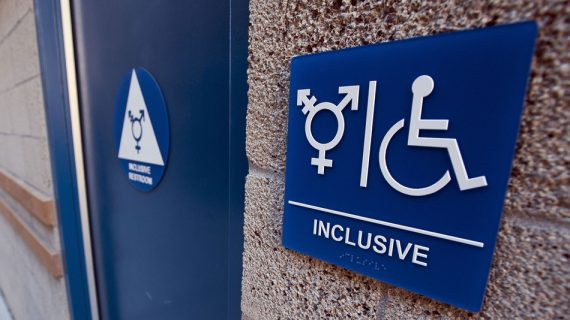

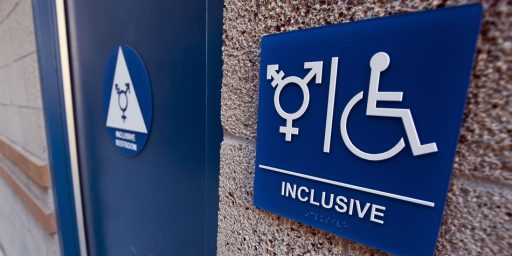
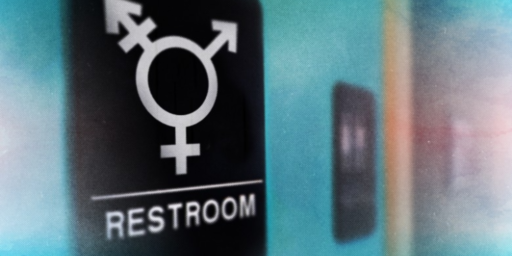
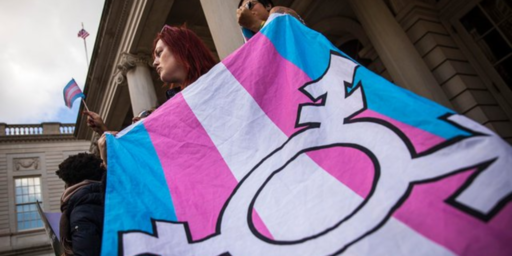
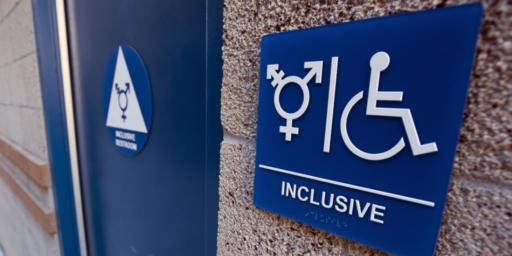
Basically, America is having a rather idiotic discussion over which bathroom Caitlynn Jenner should use.
No democracy is perfect. How much special protection or choice does .03% of the population warrant?
And… if Title 9 does not apply, then is this a states rights issue?
First of all, states don’t have rights, only individuals have rights.
Second, if Title IX doesn’t apply then the Federal Government has no authority to act in this area.
@al-Alameda:
It’s less about Caitlyn Jenner than it is what goes on in public schools.
@Doug Mataconis:
It would be nice if that were the case, but the 10th Amendment disagrees with you.
And now I shall rant…
I have yet to find anything that binds any state I have lived in together other than arbitrary lines. There are always portions that have far more in common with the neighboring states, or similar portions of neighboring states. Pennsyltucky has more in common with upstate New York than it does with Philly.
Granting states powers over the individuals who happen to live inside those lines is like creating separate laws for people whose social security numbers are divisible by 17 — sure, that’s a grouping that can be made, but it doesn’t serve any purpose.
States may have once been useful, but now they are just arbitrary entities.
@Gustopher:
The 10th Amendment doesn’t talk about rights, it talks about powers reserved to the states. Those powers are subject to the limitations set forth in the Constitution — such as those contained in Article 1, Section 10, the 14th Amendment, the 13th, 14th,15th, 19th, 24th, and 26th Amendments, and the Bill of Rights.